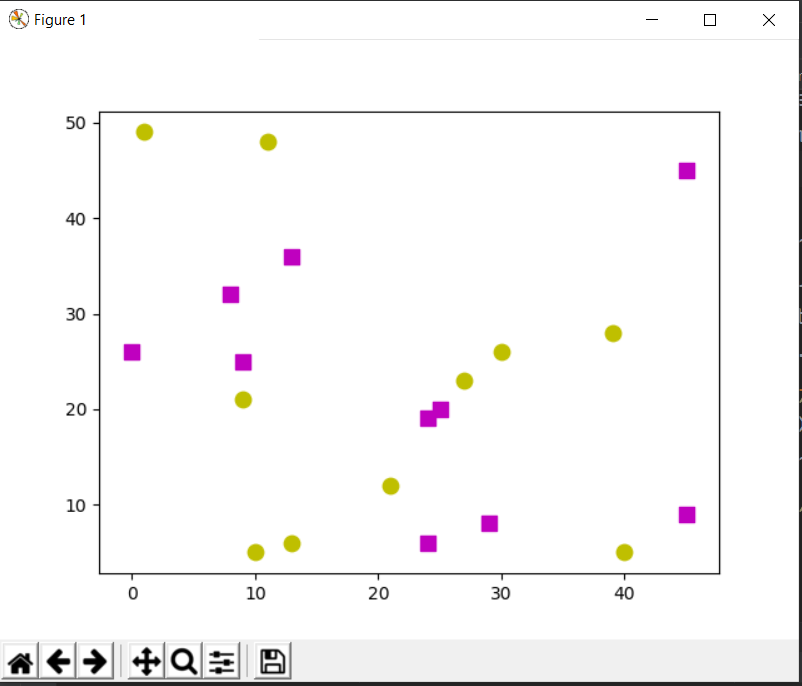使用 OpenCV 实现 KNN
KNN 是机器学习中使用最广泛的分类算法之一。要了解更多关于 KNN 算法的信息,请阅读此处 KNN 算法
今天我们将看到如何在 OpenCV 中实现该算法,以及如何在 2D 平面中可视化结果,显示我们在训练数据中拥有的类的不同特征。
让我们为我们的代码考虑两个类。我们使用随机生成器生成属于 2 个类别的 20 个随机数据点。训练点将是“洋红色”类或“黄色”类。洋红色绘制为正方形,洋红色的标签为 1,类似地,黄色绘制为圆形并标记为 0。
代码:
Python3
# Import necessary libraries
import cv2 as cv
import numpy as np
import matplotlib.pyplot as plt
# Create 20 data points randomly on the 2-D plane.
# Data_points are random points located on the 2D plane.
Data_points = np.random.randint(0, 50, (20, 2)).astype(np.float32)
# Label the data points with their class labels.
labels = np.random.randint(0, 2, (20, 1)).astype(np.float32)
# labels are the classes assigned to data points.
# Take the yellow class for 0 label and magenta class for 1 label
yellow = Data_points[labels.ravel()== 0]
magenta = Data_points[labels.ravel()== 1]
# Plot the classes on the 2-D plane
# o for circle
plt.scatter(yellow[:, 0], yellow[:, 1], 80, 'y', 'o')
# s for square
plt.scatter(magenta[:, 0], magenta[:, 1], 80, 'm', 's')
plt.show()Python3
# generate a random data point
# unknown is a random data point for which we will perform prediction.
unknown = np.random.randint(0, 50, (1, 2)).astype(np.float32)
# create the knn classifier
knn = cv.ml.KNearest_create()
# we use cv.ml.ROW_SAMPLE to occupy a row of samples from the samples.
knn.train(Data_points, cv.ml.ROW_SAMPLE, labels)
# get the labelled result, the numbers, the distance of each data point.
# find nearest finds the specified number of neighbours and predicts responses.
ret, res, neighbours, distance = knn.findNearest(unknown, 5)
# For each row of samples the method finds the k nearest neighbours.
# For regression problems, the predicted result is a mean of all the neighbours.
# For classification, the class is determined by the majority.
# plot the data point with other data points
plt.scatter(unknown[:, 0], unknown[:, 1], 80, 'g', '^')
# show the result.
plt.show()
# print the results obtained
print( "Label of the unknown data - ", res )
print( "Nearest neighbors - ", neighbours )
print( "Distance of each neighbor - ", distance )输出:

现在考虑一个未知的新数据点,我们的 KNN 分类器将根据其特征和我们定义的邻居数量将该数据点标记为 0 或 1。
代码:
Python3
# generate a random data point
# unknown is a random data point for which we will perform prediction.
unknown = np.random.randint(0, 50, (1, 2)).astype(np.float32)
# create the knn classifier
knn = cv.ml.KNearest_create()
# we use cv.ml.ROW_SAMPLE to occupy a row of samples from the samples.
knn.train(Data_points, cv.ml.ROW_SAMPLE, labels)
# get the labelled result, the numbers, the distance of each data point.
# find nearest finds the specified number of neighbours and predicts responses.
ret, res, neighbours, distance = knn.findNearest(unknown, 5)
# For each row of samples the method finds the k nearest neighbours.
# For regression problems, the predicted result is a mean of all the neighbours.
# For classification, the class is determined by the majority.
# plot the data point with other data points
plt.scatter(unknown[:, 0], unknown[:, 1], 80, 'g', '^')
# show the result.
plt.show()
# print the results obtained
print( "Label of the unknown data - ", res )
print( "Nearest neighbors - ", neighbours )
print( "Distance of each neighbor - ", distance )
输出:
Label of the unknown data - [[1.]]
Nearest neighbors - [[1. 1. 0. 1. 1.]]
Distance of each neighbor - [[ 1. 65. 130. 173. 245.]]
